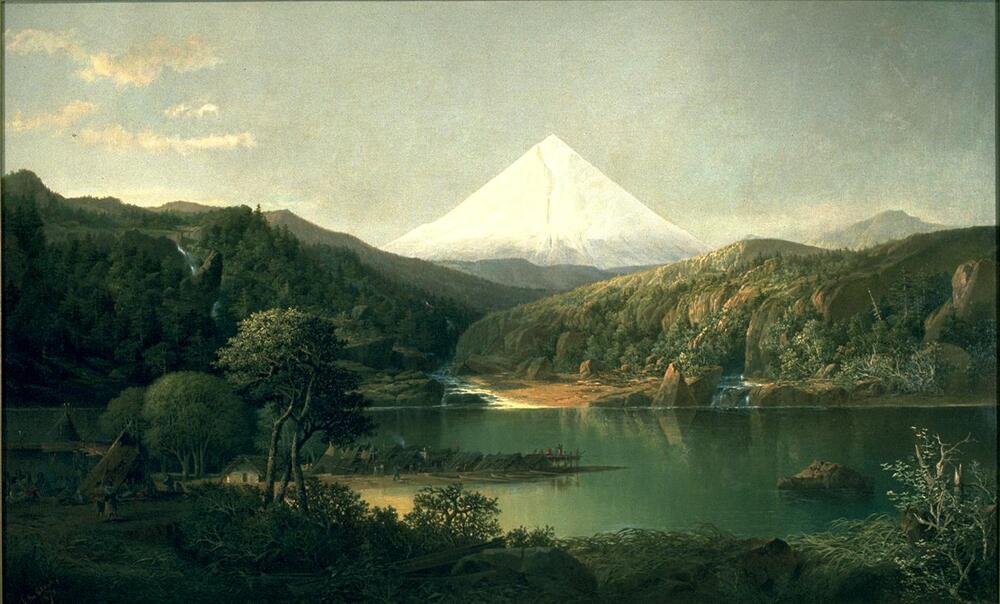Mount Hood from the Dalles, 1871
The in-depth review!
John Stanley’s Mount Hood from the Dalles, 1871, is an artwork that offers insight into the vastness of the American landscape before it was settled. Stanley creates an atmosphere with his painting technique that implies how nature looms over humans. While there is texture from brush strokes the view is still and soft, and relatively organized.
The depth and size of the painting give it a panoramic feel, as though Stanley painted the scene from very far away while still capturing intricate details. By using small forms to build up a large composition, Stanley plays on the expansiveness of the Oregon country at the time. However, the painting is not a “sublime” one because there is not chaos portrayed in the image, nor is there heavily blowing wind or an ominous sky. Stanley’s painting of Mount Hood has a photographic feel because of the atmosphere he was able to create and the sheer amount of detail captured in the painting. The photograph quality is explained because “he made his initial records of Indian life with camera and pencil and postponed execution of his paintings until after his expeditions. He also organized his canvases in a self-conscious, academic manner” (Kloss 1985). The picture shows figures in a make-shift village on the water, hinting towards the fact that people of the time were able to tame the wilderness enough to inhabit it. The figures are of native Americans both Stanley and George Catlin documented the lives of Native Americans “Like Catlin, he genuinely wanted to document Native American life and culture and felt that he was under time pressure to do so—which was realistic given the rate at which physical and cultural violence was affecting Indian communities across the continent” (Dorfman 2016). Stanley was also interested in the lives of the Native Americans that he encountered, not only painting them but keeping a diary of profiles (Rothstein 2015), one excerpt details a Seminole Indian man that offers insight into how Stanley perceived his subjects:
“Tustenuggee Chop-Ko or “The Big Warrior”: a Seminole sub-chief, “esteemed one of the best ball-players among his people.” But, Stanley notes: “His countenance indicates anything but intelligence or shrewdness; on the contrary, it exhibits evidence of a capacity to commit any act, however cruel and atrocious, at the bidding of his chief” (Rothstein 2015).
Stanley’s painting of Mount Hood allows the viewer to see a part of American history and landscape that has since been destroyed. The image is rendered beautifully and holds many small details that suck the viewer in and make it engaging to look at and reflect on the past.
Created For
K-12 EducatorK-12 Student
Museum Visitor
UMMA Docent
UMMA Staff
University Faculty
University Student
Rate this Resource
AVG: 0 | Ratings: 0
& Author Notes
All Rights Reserved (Dorfman, John. “The Vanishing Indian Painter.” Art & Antiques Magazine, 8 Mar. 2016, www.artandantiquesmag.com/2016/03/john-mix-stanley-paintings/.
This article described the fire that destroyed many of Stanley’s works and his relationship to Catlin as they traveled to the west in the mid 1800s. The article also described Stanley’s painting technique as “an extremely polished Hudson River School technique.” It helps to know that his education was a large influence on his photographic painting style. Dorfman then elaborates on the differences between Stanley and Catlin, calling Catlin a “primitive” artist because he was self taught, and Stanley was much more refined.
Kloss, William. “Treasures from the National Museum of American Art.” Washington, D.C. and London. National Museum of American Art with the Smithsonian Institution Press. 1985.
Kloss elaborates more on the way that Stanley created. He traveled far and wide to seek out subjects for his paintings, but instead of painting plen-air he “made his initial records of Indian life with a camera and pencil” and his paintings were made in a more academic manner for information, rather than an intimate look at the lives of Native Americans.
Rothstein, Edward. “'Painted Journeys: The Art of John Mix Stanley' Review.” The Wall Street Journal, Dow Jones & Company, 27 July 2015, www.wsj.com/articles/painted-journeys- the-art-of-john-mix-stanley-review-1438037228.
Rothstein views Stanley as a hunter because of his willingness to travel for miles in search of subjects, he traveled thousands of miles at a tine when doing so was tedious and challenging. What pushes the idea of him as a hunter further is the fact that he kept a journal of all the Indians he encountered and made profiles on them, almost like a trophy case. Stanley was very dedicated to his craft, and went above and beyond to make a body of work that would impress any viewer.
)
Last Updated
April 16, 2018 8:41 p.m.Report
Reporting Policy

